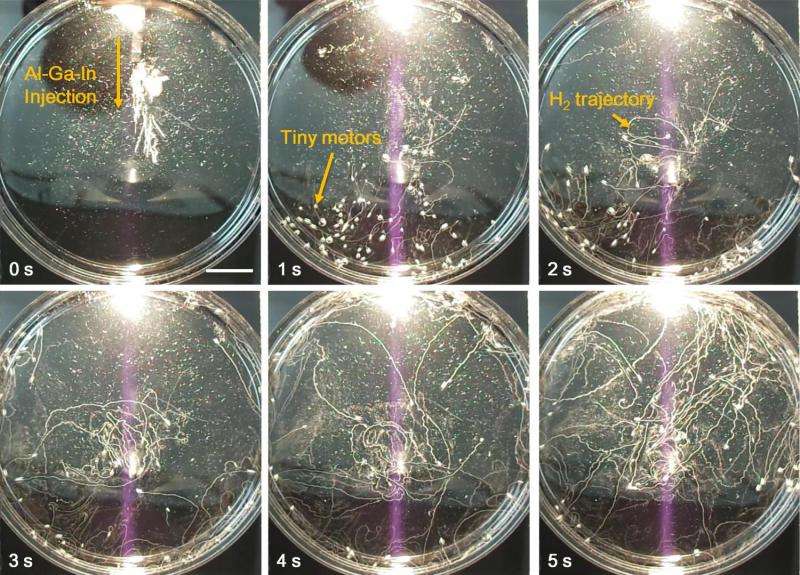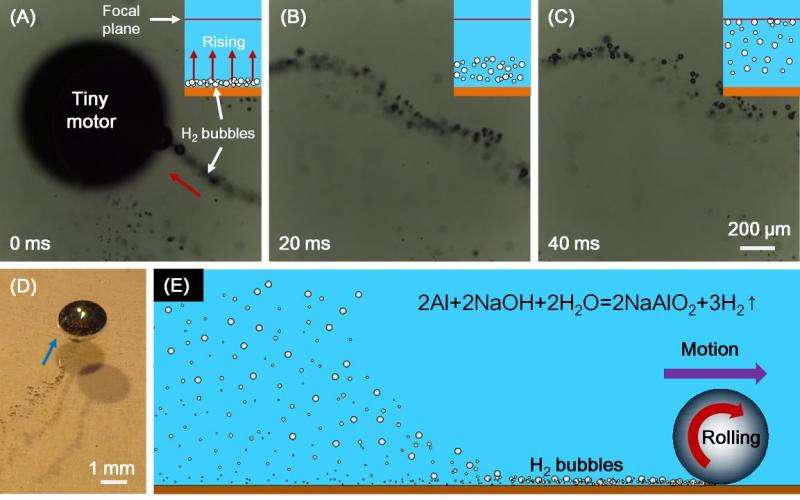Researchers find the macroscopic Brownian motion phenomena of self-powered liquid metal motors

Classical Brownian motion theory was established over one hundred year ago, describing the stochastic collision behaviors between surrounding molecules. Recently, researchers from the Technical Institute of Physics and Chemistry, Chinese Academy of Sciences discovered that self-powered liquid metal motors at the millimeter scale demonstrated similar Brownian-like motion behaviors in alkaline solution. And the force comes from the hydrogen gas stream generated at the interface between the liquid metal motor and its contacting substrate bottom.
Ever since the irregular motions of suspended grains in water was observed by Brown in 1827, tremendous efforts have been made toward a theory to characterize the Brownian motion. A half century later, the kinetic theories of heat developed by Maxwell, Boltzmann and others were merging as a possible explanation. In 1905, Einstein published a theoretical paper interpreting the stochastic process using particle diffusion constant and the fluid viscosity. This relationship bridges the microscopic dynamics with the macroscopic phenomenon, which inspired many subsequent works regarding both thermodynamics and statistical physics. Such theory was later demonstrated by the well-known Perrin's experiments. So far, most of the classical Brownian motions refer to the molecular activities that occur in microscale. There are very limited reports to investigate such phenomena in macroscale. And the phenomena are mainly focused on the particle motions caused by the surrounding liquid molecules.
In this study, researchers disclosed that macroscopic liquid metal motors at the millimeter scale showed similar Brownian motion behavior in alkaline solution. The authors dispersed the premixed liquid metal and Al (mass percentage 1%) alloy into a glass Petri dish. It was observed that each tiny motor in millimeter scale began to move swiftly and randomly on Petri dish glass. Contrary to the classical Brownian motion behavior, the main driving force of such motion comes from the hydrogen bubbles generated at the bottom of the tiny motors. Further, an optical platform with high image contrast, which works somewhat like the Wilson Cloud Chamber, was introduced to clearly depict the hydrogen bubble stream left behind the running motors.

The present findings add important new knowledge to the liquid metal motor as well as the classical Brownian motion phenomenon. The established optical image contrast method also provides an important experimental tool for further investigations along this direction.
More information: B. Yuan, S. Tan, Y. Zhou, J. Liu, "Self-powered macroscopic Brownian motion of spontaneously running liquid metal motors," Sci. Bull. (2015) 60(13):1203-1210. link.springer.com/article/10.1007%2Fs11434-015-0836-6
Provided by Science China Press



















